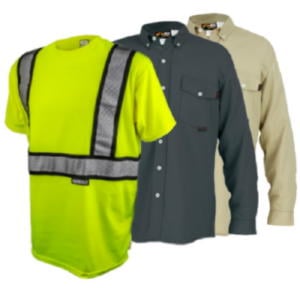Why FR Clothing?
Personal Protective Equipment

Why FR Clothing?
Flame-resistant clothing is regulated by the national consensus standard NFPA 70E. The standard creates safety guidelines for those several industries, including electricians and welders. The availability of flame-resistant clothing is more common, thanks to the NFPA 70E standard. Employers, including self-employed people, must comply with the standard if they are involved in any of the industries that require flame-resistant clothing.
Why Flame-Resistant Clothing is Important
Most people who suffer from severe burn injuries do so because they do not wear FR clothing. The non-FR clothing could melt onto the skin and cause further injury. Over 2,000 people per year enter burn centers with severe arc flash burns – every day, the United States sees an arc flash explosion send an electrical worker to the hospital or a burn center.
Flame-resistant clothing protects those in industries with the possibility of flash fires from sustaining burns. It also protects others in industries that have spark, heat and fire hazards. FR clothing is made to resist ignition. If it does ignite, it self-extinguishes.
The material also provides thermal insulation from heat sources and resists breaking open and tearing, thus keeping skin from being exposed. Finally, flame-resistant clothing does not melt onto your skin and significantly reduces injuries caused by burns. If you should receive burns, you have a much higher chance of survival since less of your body will have burns.
Do not make the mistake of thinking that flame-resistant clothing protects you against burns. Instead, it reduces the amount of body burn area that could receive second-degree burns to less than 50 percent. Those with second-degree or worse burns over more than 50 percent of their bodies have a significantly lower rate of survival than someone with burns covering less than 50 percent of their bodies.
What Flame-Resistant Clothing Protects Against
Most flame-resistant clothing is designed to protect you against electric arc flashes and flash fires. A flash fire spreads rapidly because vapors from flammable liquids ignite. Temperatures from this type of fire could reach 1,900 degrees Fahrenheit. Flash fires are more common in industries such as petrochemicals and metallurgy or other industries that manufacture combustible materials, though any environment that has electrical hazards would benefit from FR clothing.
Electric arc flash fires are when electrical current passes through ionized air. These fires generally last for less than a second, but temperatures can reach 35,000 degrees Fahrenheit. Any worker that works with exposed electrical equipment with 50 volts or more should wear flame-resistant clothing.
Complying with the NFPA 70E standard increases safety for employees, ensures that employees embrace safety culture when working in dangerous situations, significantly reduces the risk of OSHA fines, and reduces employee injuries, accident claims and lost time.
Regulations Regarding Flame-Resistant Clothing
Two types of regulations apply to those working in industries that require flame-resistant clothing: OSHA regulation and NFPA regulations.
OSHA Regulations
OSHA has four regulations that pertain to flame-resistant clothing. The general duty clause states that all employees must have a “safe and healthful workplace.” The employer must keep the workplace free of dangers that are likely to cause harm or death to its employees.
The personal protective equipment rule states that the employer must require the correct personal protective equipment for the type of hazard located at the workplace for those affected by the hazardous condition.
The Electric Power Generation, Transmission, and Distribution rule is for those who maintain and operate electric power generation, transmission, control and distribution lines and equipment. Employers must notify employees that not wearing flame-resistant clothing when working around electricity increases the risk of injury.
The Electrical Safety Related Work Practices rule states that employees who work in areas that have potential electrical hazards have access to and use protective equipment for use in the electrical industry.
National Consensus Standards (NFPA) Regulations
The NFPA has three standards that pertain to flame-resistant clothing. NFPA 2112, the Standard on Flame-Resistant Garments for Protection of Industrial Personnel Against Flash Fire, dictates the minimum performance requirements for flame-resistant materials, the test methods for the materials and the design and certification requirements for flame-resistant clothing used to protect workers against flash fires.
NFPA 70E, the Standard for Electrical Safety in the Workplace dictates electrical safety requirements for employers to safeguard employees installing, operating, maintaining, and demolishing electrical equipment, including conductors and raceways. This rule does not apply to:
- Communication and electric utility-controlled installations.
- Ships.
- Railways.
- Underground mines.
The National Electrical Safety Code covers communication and supply lines and equipment, public and private supply electric workplaces, railways, communications, and other utilities.
In addition to meeting the safety standards, employers must have to know how. The consensus standards show you how to comply, whereas OSHA focuses on the industry itself. For example, to comply with the NFPA 70E, you must perform a Flash Hazard Analysis of the workplace.
Identifying the Appropriate FR Clothing
In order to determine which fire-resistant clothing is appropriate for your workplace, you must identify the hazard type, review the standard for that particular hazard, determine how much protection your employees need, and research various flame-resistant clothing that meet the needs of your facility.
Once you complete those steps, you must evaluate the flame-resistant clothing. You can do this through safety committees, wear trials, peer references, manufacturers’ presentations, and other research.
Finally, create a flame-resistant program and make the FR clothing available to your employees. Employers can purchase the FR clothing or rent it from an industrial laundering company.
Once everything is in place, all that is left is to ensure your employees receive proper training in the use of flame-resistant clothing.
Visit Abolox for Flame-Resistant Clothing
Visit Abolox to review the flame-resistant clothing we carry. Our FR clothing line is rated pursuant to safety standards. If you do not see something you need, give us a call – we will try to source the flame-resistant clothing you are looking for.

